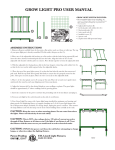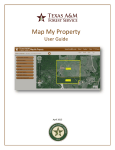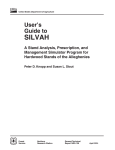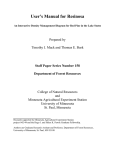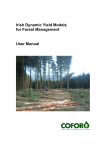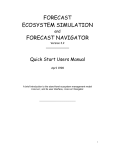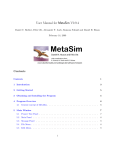Download User Manual - Forest Thinning Scheduler
Transcript
Forest Thinning Scheduler User’s Guide Texas A&M Forest Service and other members of Texas A&M System provide equal opportunities in programs, education and employment, without regard to race, color, sex, religion, national origin, age, disability, genetic information, or veteran status. _____________________________________________________ Texas A&M Forest Service makes no warranties or guarantees, either expressed or implied, as to the completeness, accuracy, or correctness of the data provided in this report nor accepts any liability arising from any incorrect, incomplete, or misleading information contained therein. All information, data, and databases are provided “as is” with no warranty, expressed or implied, including, but not limited to, fitness for a particular purpose. By accessing this Forest Thinning Decision Support System website and/or data contained within the databases, you hereby release Texas A&M Forest Service and its employees, agents, contractors, and suppliers from any and all responsibility and liability associated with its use. In no event shall Texas A&M Forest Service or its officers or employees be liable for any damages arising in any way out of the use of the website or use of the information contained in the databases herein, including, but not limited to the Texas Forest Information products. Table of Contents Links ..................................................................................................................................................................................................... 5 TexasForestInfo.tamu.edu ..................................................................................................................................................... 5 About .............................................................................................................................................................................................. 5 Help ................................................................................................................................................................................................. 5 Contact ........................................................................................................................................................................................... 5 Texas A&M Forest Service Logo .......................................................................................................................................... 5 Tabs ...................................................................................................................................................................................................... 6 Introduction................................................................................................................................................................................. 6 Description (Forest Stand Description) ........................................................................................................................... 6 Scenario Name.......................................................................................................................................................................6 Description..............................................................................................................................................................................7 Region ....................................................................................................................................................................................... 7 Stand Type ..............................................................................................................................................................................7 Species ...................................................................................................................................................................................... 7 Stand age.................................................................................................................................................................................. 7 Stand density.......................................................................................................................................................................... 7 Site Index ................................................................................................................................................................................. 7 Include Site Index Adjustment for Base Age = 50:.................................................................................................. 7 Set to default .......................................................................................................................................................................... 8 Clear form ................................................................................................................................................................................ 8 Activities (Prior Forest Management Activities).......................................................................................................... 8 Genetic gain ............................................................................................................................................................................8 Stand previously thinned .................................................................................................................................................. 8 Thresholds (Thinning Decision Threshold) ................................................................................................................... 9 Primary management objective ..................................................................................................................................... 9 Tolerance to investment risk .......................................................................................................................................... 9 Age at final harvest ........................................................................................................................................................... 10 Increased chance of environmental stressors?..................................................................................................... 10 Maximum SDI...................................................................................................................................................................... 10 Adjust SDI for planting density.................................................................................................................................... 10 Submit Tab ................................................................................................................................................................................ 10 Site Index .............................................................................................................................................................................. 11 Initial diameter................................................................................................................................................................... 11 Genetic gain over base .................................................................................................................................................... 11 QMD where thinning begins ......................................................................................................................................... 11 Average height.................................................................................................................................................................... 11 Initial Stand Density Index ............................................................................................................................................ 11 Upper limit SDI and thinning required .................................................................................................................... 11 Lower limit SDI thinning target .................................................................................................................................. 11 Density-dependent upper SDI limit ........................................................................................................................... 11 Scenario navigation buttons ................................................................................................................................................... 11 Scenario selection .................................................................................................................................................................. 11 Results......................................................................................................................................................................................... 12 Forest Thinning Scheduler – User Guide 3 Links TexasForestInfo.tamu.edu Clicking the TexasForestInfo.tamu.edu will take you to the Texas Forest Information Portal. URL = http://texasforestinfo.tamu.edu About Click About to bring up a brief statement describing the Forest Thinning Scheduler application. Help Click the Help link available on the main page to access this user guide. In addition to the PDF user manual provided, “tool tips” for each specific step are provided with a simple mouse rollover on any of the input fields. Contact Texas A&M Forest Service invites you to provide feedback on the Forest Thinning Scheduler application. Please provide your questions, comments and suggestions for improvement by clicking the Contact link. Texas A&M Forest Service Logo Click on the Texas A&M Forest Service Logo to go to the Texas A&M Forest Service main page. URL = http://texasforestservice.tamu.edu Forest Thinning Scheduler – User Guide Table of Contents 5 Tabs Introduction This default screen provides the following brief directions to quickly begin a thinning scheduler session. • • • • Starting with the Description tab above, enter the appropriate information in the Description tab, Activities tab, and Thresholds tab for Scenario 1. If desired, click on Scenario 2 button to input different values for a second scenario on each tab. Repeat for Scenario 3, if desired. Once all inputs have been successfully entered, click on the Submit tab. Review inputs, and click the Submit button at the bottom of the page to run the analysis. Click on the Results button in the left, navigation screen to review results. Results can be viewed individually for each scenario or collectively across all scenarios. Description (Forest Stand Description) The following descriptive characteristic of the user’s forest stand are entered on this tab. Scenario Name This field is optional. This application provides you the opportunity to compare up to three separate scenarios side-by-side. Scenarios may differ by planting density, management objectives, harvest age, adversity to risk, and many other user-defined inputs. Providing a meaningful name may prove useful in keeping track of the various scenarios. Forest Thinning Scheduler – User Guide Table of Contents 6 Description This field is optional. This application provides you the opportunity to compare up to three separate scenarios side-by-side. Scenarios may differ by planting density, management objectives, harvest age, adversity to risk, and many other user-defined inputs. Providing a short description may prove useful in keeping track of the various scenarios. Region This field is required. Because the same species grows differently in different regions, the optimum thinning schedule will vary based upon the region. Select the appropriate region of the U.S. using the following image as a guide. Note: only one region, Western Gulf, is available at this time. Stand Type This field is required. Choose the type of stand from the following options: Note: only the stand type, Plantation, is available at this time. • Plantation = Tree plantations are usually easily distinguished from natural forests by the trees being planted in straight line and the site artificially regenerated using seedlings. • Natural Single = A naturally regenerated stand in which at least 80% of the trees in the main canopy are of a single species. These stand do not have trees planted in straight line and the renewal of the forest crop comes from seed fallen from mature trees on or near the site or by sprouting from roots and stumps. • Natural Mix = A naturally regenerated stand in which less than 80% of the trees in the canopy are of a single species. Species This field is required. Choose the prominent species in the stand. Note: only the species, loblolly pine, is available at this time. Stand age This field is required. If plantation, enter the age of the trees or the number of years since the stand was artificially regenerated plus one year. Value must be equal to or greater than 1. If natural stand, approximate the number of years since the major disturbance (e.g., harvest, fire, hurricane) occurred that cause significant regeneration and new cohort of trees. Stand density This field is required. Enter the current, average number of trees per acre. Site Index This field is required. Site Index (SI) is commonly used to describe the productivity of a forest site. SI reports the expected height of the dominant and co-dominant, "free to grow" trees of a given species growing on the site at some base age. Commonly used base ages include 25 and 50 years. Soil maps commonly use a base age of 50. For many species, such as loblolly pine, most growth and yield models prefer to use base age of 25. For example, loblolly pine growing on an average quality site in the Western Gulf region might reach 65 feet in 25 years. In this example, SI = 65base25. Include Site Index Adjustment for Base Age = 50 This field is for the advanced user. Site Index estimates often report the woods-run or provenancial productivity of a forest site and does not necessarily represents well the height Forest Thinning Scheduler – User Guide Table of Contents 7 potential expressed through modern management practices and genetic gain expressed by available seedlings. This features allows the user to include an estimated gain value when entering site index at base age = 50 as reported with soil data sheets. Set to default Sets the fields on the Description page to default values Clear form Clears the fields on the Description page of any values Activities (Prior Forest Management Activities) Prior forest management activities such as any previous thinnings can help with calculating accurate results. This tab provides a place to add this information. Genetic gain This field is required. Genetic gain in crop tree comes from a robust selection process whereby progeny (offspring) produced from the selection process express superior performance (gain) in various traits of interest (e.g. growth). These offsprings are often tested across a wide variety of sites over a number of years and their performance gains are recorded. If artificially regenerated, this application allow entry of the reported % gain in volume expected from the family of seedling planted. For example, many of the 2nd generation loblolly pine family express 25 – 30% gain in volume over woods-run loblolly. The default is set to 27% for loblolly pine which is typical of the gain expressed by the least expensive nursery stock available today. Stand previously thinned This field is optional. Older stands may have already undergone a thinning of some type. If so for your stand, select Yes here. You will need to enter the following additional information to complete this option. Age of previous thin: Enter the age of the stand when it was last thinned. Note: at this time, the Thinning DSS only allows one previous thin entry. If the stand has been thinned more than once, use the parameters for the most recent thin. Measure of Intensity: If previous thin is chosen then some determination of the intensity of the thin is required to proceed. These values can either be entered as trees per acre or basal area. If you know the number of trees per acre before and after the thin, then select Density. If you Forest Thinning Scheduler – User Guide Table of Contents 8 know the Basal Area of the stand before the thinning was conducted and after the thinning, then select Basal area. Density (Basal Area) before thinning: If Density selected above, enter the average number of trees per acre just prior to the thinning operation. If Basal Area select above, enter the basal area of the stand just prior to the thinning operation. Density (Basal Area) after thinning: This field is an advanced search field. If Density selected above, enter the average number of trees per acre remaining after the thinning operation. If Basal Area select above, enter the basal area of the stand after the thinning operation. Thresholds (Thinning Decision Threshold) The Thresholds tab contains the last group of variables needed to calculate a thinning schedule. Primary management objective This is a required field. Long-term forest management objectives vary widely by landowners. These objectives, along with the limits of the forest ecosystem and the dynamics of the forest vegetation determine the appropriate silvicultural practices used. Silviculture practices are the actual on-the-ground practices used to achieve the management objectives. This program considers the user-selected management objective in determining the optimum thinning schedules. Income generation focused management, such as timber, is often associated with high capital investment and may warrant delayed and/or more aggressive thinning schedules than those management objectives that are habitat-focused or recreational focused objectives. Tolerance to investment risk This is a required field. Many forest stands are held as investments and all investments hold some degree of risk. Some individuals may be more adverse to risk than others. An aggressive investor, or one with a high-risk tolerance, is willing to risk losing money to get potentially better results. A conservative investor, or one with a low risk tolerance, favors investments that maintain his or her original investment. This program will adjust the thinning decision thresholds based upon the selected level of risk. If “low” tolerance is selected, the optimum thinning window is skewed towards maintaining slightly less dense stands than required to meet the biological optimum needs of the stand under average environmental conditions. Risk of catastrophic loss is reduced at the consequence of optimum timber production. If “high” tolerance is select, thinning schedules are skewed to hold higher densities for a longer period of time increasing risk of catastrophic loss while increasing the potential for a greater return on investment (increase production of timber). Forest Thinning Scheduler – User Guide Table of Contents 9 Age at final harvest This is a required field. If preferred, you may enter the age of the stand at which you would like to conduct a final harvest. Although long for production forestry investment, a common age for loblolly pine is 32 years. Increased chance of environmental stressors? This field is for the advanced user. Some regions in the U.S. have highly variable climate that may increase the chance and magnitude of environmental stressors impact on forest stands. This may lead to slowed growth, loss of vigor, and decreased resiliency to insects, disease, fire, excessive weather events, etc. If this option is chosen, the Forest Thinning Scheduler application will adjust the thinning decision thresholds accordingly to promote tree vigor, health, resistance, and resilience to environmental stressors. Maximum SDI This field is for the advanced user. Stand Density Index (SDI) is a relative measure of stand density. It is based upon the relationship between average tree size and number of trees per acre in a fully stocked even-age stand. Species and the regions for which they are grown express different values for Maximum SDI which is the maximum index that a stand can reach with maximum competition. Typical Maximum SDI value for loblolly pine is 450. Producers in northern portions of the Western Gulf region of the U.S., may benefit by using 400 as the Maximum SDI value. Adjust SDI for planting density This field is for the advanced user. Most models usually assumed that the relative value between the stand density index (SDI) threshold where self-thinning is expected to begin is constant regardless of planting density. Modern forest stand establishment practices, however, often recommend significantly lower planting densities (depending upon species, site, objectives), which have shown to alter the point in the stand’s development at which self-thinning, began for some species. Selecting this value will adjust the SDI thresholds according to initial planting density, but may result in non-optimum thinning schedules for most typical stands. In most instances, adjusting for the initial planting density is not necessary for achieving satisfactory results. Submit Click on the Submit tab to review entered data before running a simulation to determine the optimum thinning schedule. User-entered data is provided in the first three subsections on the screen (Forest Stand Description, Prior Forest Management Activities, and Thinning Decision Thresholds). The following additional, calculated values required to run the simulations are listed in the last section labeled as Calculated Model Inputs Forest Thinning Scheduler – User Guide Table of Contents 10 Site Index The calculated SI at base age 25 for the described stand Initial diameter The average quadratic mean diameter (units = inches) of trees in the described stand. Diameter is the straight line passing from side to side through the center of the tree at 4.5 feet above average ground line. Be careful not to confuse diameter with a tree’s circumference. Genetic gain over base Depending upon the species, the poorest seedlings provided by most nurseries still provides a significant gain in production over wood-run (provenancial) stock. This is called the base gain. This program determines the difference between the base gain per species and the planting stock genetic gain value entered by the user on the Forest Stand Description tab. QMD where thinning begins As the forest stand grows, crop trees begin to compete with each other for limited resources. This competition ultimately leads to reduced vigor, growth and tree death by some individual trees…a process call self-thinning. This value estimates the size (as quadratic mean diameter) that the trees will be when the self-thinning process begins. Average height This is the calculated average height (in feet) of the tallest (dominant and co-dominant) trees in the stand. Initial Stand Density Index The calculated Stand Density Index (SDI) for the described forest stand. Upper limit SDI and thinning required This value is determined from the various user inputs including management objective, risk adversity, species, and region. It represents an estimated target SDI value, which once reached as the stand grows, triggers the program to schedule a thinning activity. Lower limit SDI thinning target Based upon user inputs, this value represents the target SDI of the residual stand after thinning. This value is used to determine the number of trees to harvest during a thinning operation. Density-dependent upper SDI limit The estimated upper limit SDI thresholds adjusted by the initial planting density in which a thinning operation should be scheduled. This value is used only if the user selected “yes” on the “Adjust SDI for planting density” field on the “Thresholds” tab. Scenario navigation buttons Scenario selection This application processes and compares the results for up to three scenarios simultaneously. Each scenario is accessed by clicking on the scenario navigation buttons at the left of the screen. Unique information may be entered on the Description, Activities, and Thresholds tab for each separate scenario. Forest Thinning Scheduler – User Guide Table of Contents 11 Results Once the user clicks on Submit at the bottom of the Submit tab to run the simulation, the results can be viewed by clicking on the Results navigation button. The user can either look at the results for each scenario separately, or side-by-side by clicking on All Scenarios tab. Acknowledgements The Forest Thinning Scheduler application was developed by Texas A&M Forest Service in partnership with and funded in part by Forest Thinning Scheduler – User Guide Table of Contents 12












